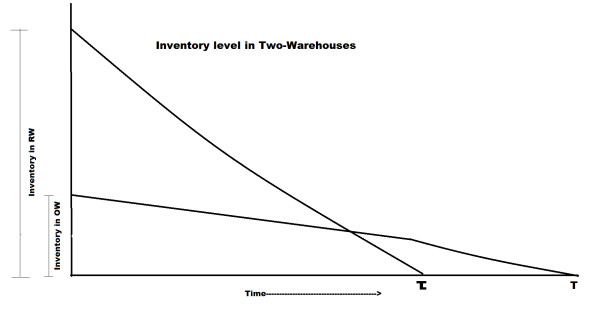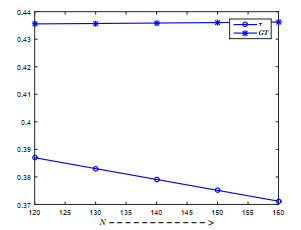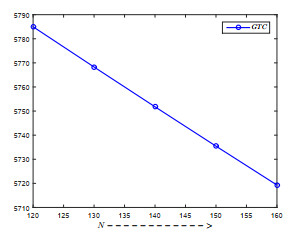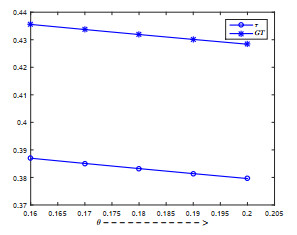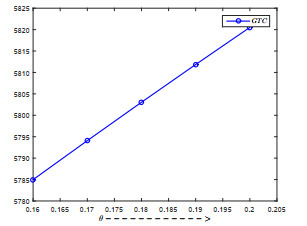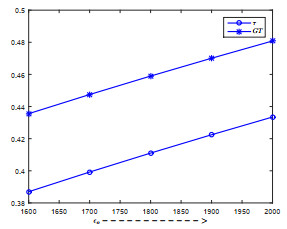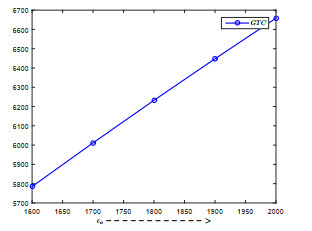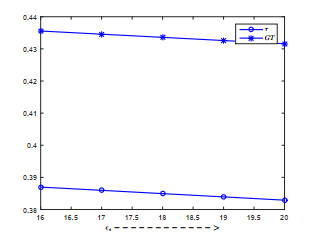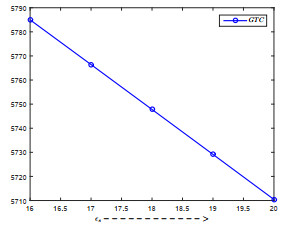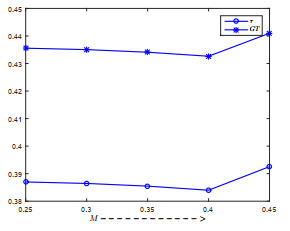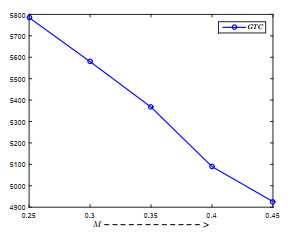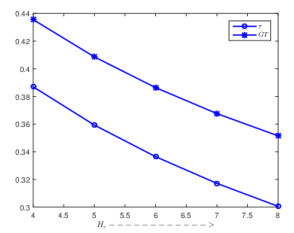1.
Introduction
In day-to-day life, inventory management plays a key role in the most of the business firms, organizations and retail management, etc. The objective of the inventory management is to minimize the total inventory cost by deciding the time when a replenishment of items to be occurring and the amount of such replenishment is to be ordered. While developing inventory models, researchers consider many constraints such as demand, deterioration, warehouse facility, ordering cost, holding cost, inflation, shortages, backlogging, trade credit, advertisement cost and so on.
Deterioration means spoilage, decay, damage or loss of its utility for the original purpose of items. This leads to increase in the inventory cost. So, it acts as a key component of the inventory management systems for most of the business firms. Thus, it's drawn the considerable attention by researchers and academicians. Initially, Ghare and Schrader [1] incorporated the deterioration in their EOQ model. Recently, Mishra et al. [2], Banerjee and Agrawal [3], Tiwari et al. [4], Chen et al. [5], Zhang and Wang [42], Braglia et al. [7], and Alvarez et al. [8], and Shaik et al. [9] developed inventory models by considering different deteriorations.
In classical inventory models, based on the existing historical data, researchers consider the demand, deterioration, holding cost, deterioration cost and other constraints; but in general, these decisions may have vagueness due to lack of accurate information and the ambiguity arising from the qualitative judgment of decision-makers. For instance, estimated demand for inventory model may have uncertainty due to introduction of substitute products into the market or in the case of single period inventory. Also, the competitors strategy to increase their sales may affect the estimated demand. As a result, the total amount of items ordered for the cycle becomes deficit or surplus to the actual requirement. Thus, the crisp values for the parameters associated with inventory are inadequate to model the real world stock management problems. Hence, to overcome these imprecisions in inventory constrains many researchers incorporated fuzziness in their models. Initially, Lee and Yao [43] considered fuzziness in demand and production quantity constraints in their economic production quantity model. Consequently, Kao and Hsu [11], Dutta et al. [45], Wang et al. [13], Sadeghi et al. ([14,35]), and Kundu et al. [38] assumed fuzzy demand in their inventory models. Next, Maiti and Maiti [17], and Rong et al. [18] considered fuzzy lead time in their inventory models. Shabani et al. [19] considered both demand and deterioration as fuzzy numbers for their inventory problem. Further, Singh et al. [20], Samal and Pratihar [21], Mahata and Mahata [22], Jain et al. [23], Shaikh et al. [28] and Pal et al. [25] developed their inventory models in fuzzy environment.
In the present competitive business world, it is very difficult for the retailer to get a warehouse with sufficient space to store the items and operate it as a sales center in a busy market place due to scarcity of space and high rent. So, they maintain a decorative showroom at busy market places to attract the customers in return boost their sales. At the same time, to avoid heavy rent, a separate warehouse may be little away from the market is used for storage. Further, retailer place the order for more quantity than the existing storage capacity, when the seasonal products or new products having high demand arrives to the market. Also, it has been observed that, when a supplier offers a price discount or trade credit financing, retailer purchase the items in bulk. In such scenarios, to accommodate the excess amount of items, the retailer may hire a warehouse on rent basis. Thus, by recognizing these practical situations, many researchers developed two warehouse inventory models. An early discussion on two warehouse inventory model was made by Hartley [26]. Following Hartley [26], Sarma [27], Pakkala and Achary [28], Lee and Hsu [29], Yang [30], Agarwal et al. [31], Sett et al. [32] and Shaik et al. [33] developed two warehouse house inventory models by considering deterministic demand.
In the traditional inventory models, it is often assumed that the supplier receives his payment as soon as the retailer receives the items. But, with the change in business trend and globalization, many multinational companies enter into the retail business. This effects a fierce competition among the suppliers to enhance their business. So, they are implementing many strategies to promote their sales. Among all those, trade credit financing has been popularly acknowledged as an imperative way to increase the sales. Since, the trade credit offer encourages the existing retailers to purchase more quantity and attract new retailers. This causes a decrease in on-hand inventory and holding cost of the supplier. Moreover, beyond the offer period supplier collect the interest on due amount from the retailer. As a result, supplier maximizes his profit and minimizes the inventory cost. On the other hand, trade credit offer acts as an alternative price discount, reduction in ordering cost and investment capital to the retailer. During the credit period, retailers can earn the interest on revenue accumulated by selling the items and this may improve retailer's profit. Though, a retailer buys more quantity to avail the benefits of trade credit. In fact, the existing warehouse is not enough to keep these items. Then the situation demands retailer to hire a rented warehouse. Thus, the above literature motivated many researchers to incorporate the concept of trade credit financing in their inventory models. In this direction, the first attempt was made by Haley and Higgins [34]. Later on, many researchers contributed their work in the field of trade credit financing. Recently, Liang and Zhou [35], Liao et al. [36], Guchhait et al. [42], Lio et al. [38], Bhunia et al. [39], Jaggi et al. ([40,43,46]), Bhunia and Shaikh [41], Tiwari et al. [42], Kaliraman et al. [45], and Chakraborthy et al. [45] obtained useful results in their inventory problems having two warehouse facility under trade credit financing. Further, Shabani et al. [19], Sing et al. [20], and Rong et al. [18] developed two warehouse inventory model with trade credit financing by considering one or more fuzzy constraints. Next, Shaikh et al. [28] and Mahata and Mahata [22] obtained optimal result for a fuzzy EOQ model by considering trade credit.
Motivated essentially by the above discussed aspects, we develop a two warehouse cost optimization model for the inventory items having fuzzy demand and deterioration under trade credit financing. In particular, we have considered the triangular fuzzy numbers for the associated demand and deterioration parameters, and the Graded Mean Integration Representation (GMIR) technique is used for defuzzification in view of getting the results in crisp versions. The model is also supported by numerical examples justifying the validity of the study. The overall aim of the authors is to obtain, the more realistic, optimal values for total inventory cost and replenishment time. Finally, sensitivity analysis of major parameters is conducted to draw the managerial insight on optimal solution. The literature related to present study as discussed above is presented briefly in Table 1.
2.
Assumptions and notations
2.1. Assumptions
Assumptions made for the model are as follows:
(ⅰ) all items in the inventory are of the same kind
(ⅱ) items in the inventory have fuzzy exponential demand and constant fuzzy deterioration
(ⅲ) inventory designed for Two-Warehouses (that is, Owned Warehouse (OW), and Rented Warehouse (RW))
(ⅳ) owned warehouse has limited capacity to store the items; where as the rented warehouse has infinite capacity
(ⅴ) there is no loss of customers during the cycle, that means, shortages are not allowed
(ⅵ) the lead time is negligible
(ⅶ) the rate of deterioration in RW is less than that of OW, since it provides better facilities than of OW
(ⅷ) the holding cost of items in RW is greater than that of OW, as it includes transportation charges and better facilities
(ⅸ) the rate of replenishment is infinite
(ⅹ) the maximum number of deteriorating units in OW should not exceed the demand at any time.
2.2. Notations
Following notations are used while developing the model.
R(t): Demand function (R(t)=˜αe˜βt ˜α>0,0<˜β<1, with fuzzy parameters).
N: The maximum number of items can be stored in OW.
˜κ: Fuzzy rate of deterioration in OW.
˜λ: Fuzzy rate of deterioration in RW.
ϵo: Ordering cost per cycle.
ϵp: Purchase cost per unit item.
ϵs: Selling price per unit item.
Ho: Holding cost in OW per unit item.
Hr: Holding cost in RW per unit item.
τ: At which RW becomes empty.
T: At which OW becomes empty, that is, total cycle time.
Qo(t): Inventory level at any time t in OW, t∈[0,T].
Qr(t): Inventory level at any time t in RW, t∈[0,τ]
M: Trade Credit period offered by the supplier.
θ: Rate of interest on payable amount.
ϑ: Rate of interest earned on revenue accumulated by selling the items.
~TC(τ): Fuzzy total cost of the inventory.
GTC(τ): Defuzzified total cost of inventory.
GT: Defuzzified total cycle time.
3.
Mathematical model
The inventory cycle is started with W items at t=0. At first, the OW is filled to its maximum capacity N, and then the rest of the items are kept in RW. To reduce the cost of the inventory system, the retailer sells the items from RW first and then sells the items from OW. The inventory level in RW decreases due to both demand and deterioration in the interval t∈[0,τ] and reaches to zero at t=τ. Similarly, the inventory level in OW decreases due to deterioration in the interval [0,τ], and due to both demand and deterioration in the interval [τ,T] both the warehouses become empty at t=T. The Figure 1 depicts the inventory level at any time t.
Inventory level in RW at any time t (0≤t≤τ) is governed by the differential equation
under the boundary condition Qr(τ)=0.
On solving Eq 1, we get
Inventory level in OW at any time t (0≤t≤τ) is governed by the differential equation
under the boundary condition Qo(0)=N.
On solving Eq 3, we get
Inventory level in OW at any time t, (τ≤t≤T) is governed by the differential equation
under the boundary condition Qo(τ)=Ne˜κ(−τ).
On solving differential Eq 5, we get
As per our assumption Qo(t) is 0 at t=T. Thus using Qo(T)=0 in equation (6) and solving for T, we get
The different costs associated with inventory are
(ⅰ) ordering cost
(ⅱ) stock holding cost
(ⅲ) deterioration cost
(ⅳ) interest payable by retailer
case 1 (M≤τ≤T)
case 2 (τ<M≤T)
case 3 (M>T)
(ⅴ) interest earned by retailer
case 1 (M≤T)
case 2 (M>T)
Thus, the total relevant fuzzy total cost of the inventory per unit time is
~TC(τ,T) = (Ordering Cost + Stock Holding Cost + Deterioration Cost + Interest Payable -Interest Earned)/T.
Therefore,
Here, we have
In above functions, use T=1˜β+˜κlog(e˜βτ+˜κτ+˜βN˜α+˜κN˜α) (see Eq 7).
Let us take fuzzy parameters ˜α, ˜β, ˜λ and ˜κ as triangular fuzzy numbers (~α1,~α2,~α3), (~β1,~β2,~β3), (~λ1,~λ2,~λ3), and (~κ1,~κ2,~κ3) respectively. Then, using Eqs 17, 18 and 19, we obtain TCij (i=1,2,3j=1,2,3) by replacing ˜α by αj, ˜β by βj, ˜λ by λj and ˜κ by κj in ~TCi. Now, by Graded Mean Integration Representation Method
we get the defuzzified total cost functions GTC1, GTC2 and GTC3.
In the similar fashion, the total cycle time can be defuzzified as
such that Tj(j=1,2,3) can be obtained by replacing ˜α by αj, ˜β by βj, ˜λ by λj and ˜κ by κj in Eq 7.
4.
Solution procedure
Our objective is to find the minimal total cost in each case. The necessary and sufficient conditions for GTCi(τ) is minimal are dGTCi(τ)dτ=0 and d2GTCi(τ)dτ2>0 (i=1,2,3). So, we have to find
(ⅰ) τ∗1 such that dGTC1(τ∗1)dτ=0 and d2GTC1(τ∗1)dτ2>0
(ⅱ) τ∗2 such that dGTC2(τ∗2)dτ=0 and d2GTC2(τ∗2)dτ2>0
(ⅲ) τ∗3 such that dGTC3(τ∗3)dτ=0 and d2GTC3(τ∗3)dτ2>0.
Next, find the corresponding GTi∗ from the equation (21) just by replacing τ by τ∗i(i=1,2,3).
Algorithm to find the optimal solution
Among all the minimal solutions the optimal solution can be found as follows:
Step 1 If M≤τ∗1≤GT1∗, then set τ∗=τ∗1,GT∗=GT1∗ and GTC∗(τ)=GTC1(τ∗)
Step 2 If τ∗2<M≤GT2∗, then set τ∗=τ∗2,GT∗=GT2∗ and GTC∗(τ)=GTC2(τ∗)
Step 3 If τ∗3<GT3∗<M, then set τ∗=τ∗3,GT∗=GT3∗ and GTC∗(τ)=GTC3(τ∗)
Step 4 If all the three steps fail, then set GTC∗(τ) = min{GTC1(τ∗1),GTC2(τ∗2),GTC3(τ∗3)} and τ∗ = argmin{GTC1(τ∗1),GTC2(τ∗2),GTC3(τ∗3)}. GT∗ can be find from the corresponding τ∗ from the Eq 21.
Finally, the optimal solutions are τ∗,GT∗>C∗(τ).
5.
Numerical examples
Example 1 [Case 1 (M≤τ≤T)]
ϵo=1600,ϵp=10,ϵs=16,Ho=1,Hr=4,M=0.25,θ=0.16,ϑ=0.12,N=120, (~α1,~α2,~α3)=(1500,2000,2500), (~β1,~β2,~β3)=(0.2,0.4,0.6), (~λ1,~λ2,~λ3)=(0.06,0.08,0.1), and (~κ1,~κ2,~κ3)=(0.1,0.2,0.3).
Solution The optimal solution is τ∗=0.38698, GT∗=0.435557 and GTC∗=5784.98.
Example 2 [Case 2 (τ<M≤T)]
ϵo=1630,ϵp=15,ϵs=22,Ho=5,Hr=12,M=0.18,θ=0.2,ϑ=0.12,N=300, (~α1,~α2,~α3)=(350,850,1350), (~β1,~β2,~β3)=(0.4,0.6,0.8), (~λ1,~λ2,~λ3)=(0.1,0.12,0.14), and (~κ1,~κ2,~κ3)=(0.3,0.4,0.5).
Solution The optimal solution is τ∗=0.140665, GT∗=0.449989 and GTC∗=6541.33.
Example 3 [Case 3 (M>T)]
ϵo=2830,ϵp=15,ϵs=22,Ho=5,Hr=11,M=0.35,θ=0.2,ϑ=0.15,N=1000 (~α1,~α2,~α3)=(3750,4250,4750), (~β1,~β2,~β3)=(0.4,0.6,0.8), (~λ1,~λ2,~λ3)=(0.1,0.2,0.3), and (~κ1,~κ2,~κ3)=(0.2,0.4,0.6).
Solution. The optimal solution is τ∗=0.0609184, GT∗=0.262608 and GTC∗=14609.4.
6.
Sensitivity analysis
Sensitivity of parameter θ
From the Table 2 and Figures 2 and 3, we conclude that as the rate of interest on payable amount θ increases; (a) the inventory time of RW (τ) decreases, (b) the total cycle time (GT) decreases, and (c) the total inventory cost (GTC) increases significantly.
Sensitivity of parameter N
From the Table 3 and Figures 4 and 5, we conclude that as the storage capacity N of owned warehouse (OW) increases; (a) the inventory time of RW (τ) decreases, (b) the total cycle time (GT) decreases very slowly, and (c) the total inventory cost (GTC) decreases significantly.
Sensitivity of parameter ϵo
From the Table 4 and Figures 6 and 7, we conclude that as the ordering cost ϵo increases; (a) the inventory time of RW (τ) increases, (b) the total cycle time (GT) increases, and (c) the total inventory cost (GTC) increases.
From the Table 5 and Figures 8 and 9, we conclude that as the selling price ϵs increases; (a) the inventory time of RW (τ) decreases, (b) the total cycle time (GT) decreases, and (c) the total inventory cost (GTC) decreases.
Sensitivity of parameter M
From the Table 6 and Figures 10 and 11, we conclude that as trade credit period M increases; (a) the inventory time of RW (τ) decreases, but increases after certain trade credit period, (b) the total cycle time (GT) decreases, but increases after certain trade credit period, and (c) the total inventory cost (GTC) decreases.
Sensitivity of parameter Hr
From the Table 7 and Figures 12 and 13, we conclude that as trade credit period M increases; (a) the inventory time of RW (τ) decreases, (b) the total cycle time (GT) decreases, and (c) the total inventory cost (GTC) decreases.
7.
Conclusions
The inventory management of items having imprecise demand and deterioration is quite relevant in present business. So, we have developed a Two-Warehouse inventory model with a Trade Credit offer for the items following fuzzy demand and fuzzy deterioration. While developing the model we considered no shortages and the holding cost of items in RW is higher than of OW, as it provides better preserving facility and includes transportation charges. Furthermore, triangular fuzzy numbers and Graded Mean Integration Representation Method is used. The mathematical model is validated with examples in different cases arise due to trade credit offer. Moreover, the sensitivity behavior of different parameters are examined and are presented in the form of tables and figures. This article can be extended by incorporating shortages with allowance of backlogging. Also, one may include different types of demand functions with deterioration under inflation and time value of money.
Conflict of interest
The authors declare no conflict of interest.









 DownLoad:
DownLoad:
